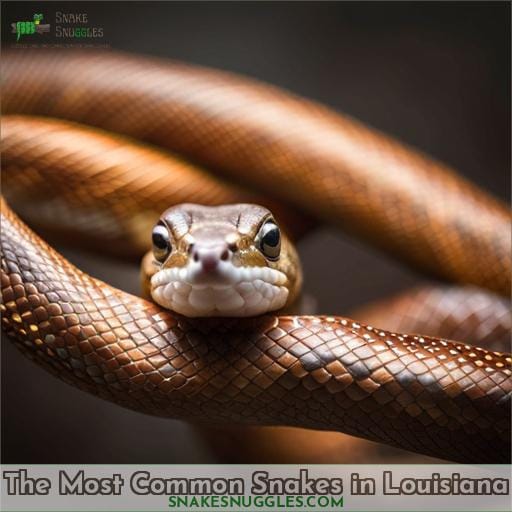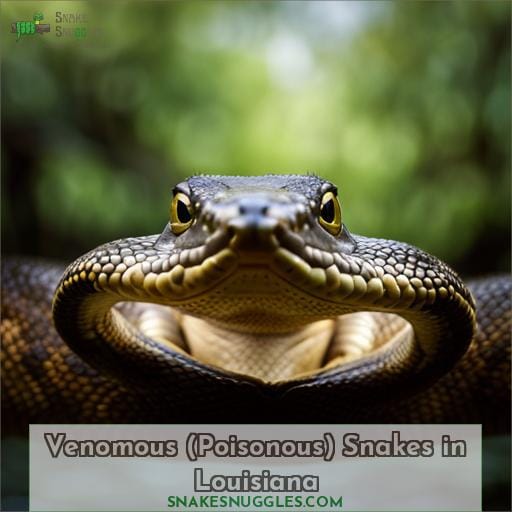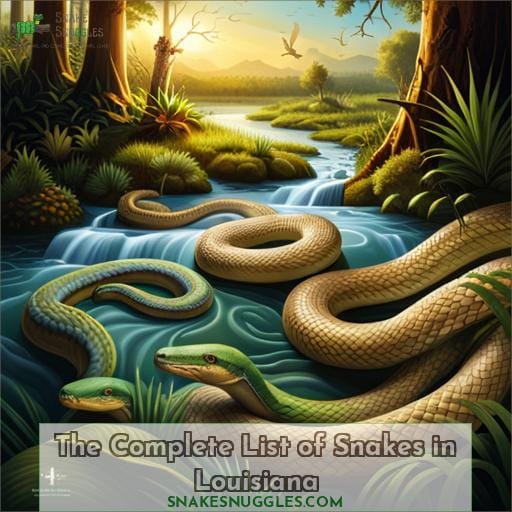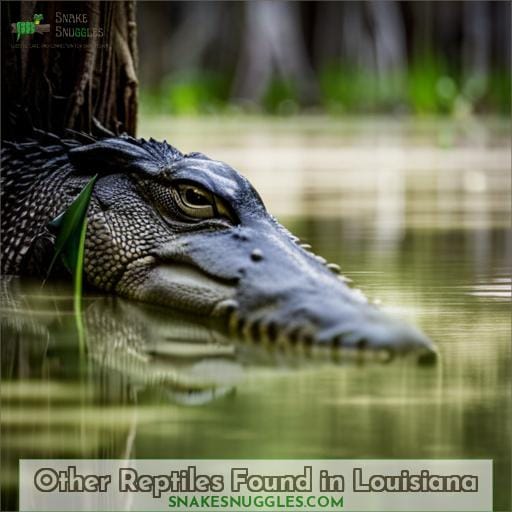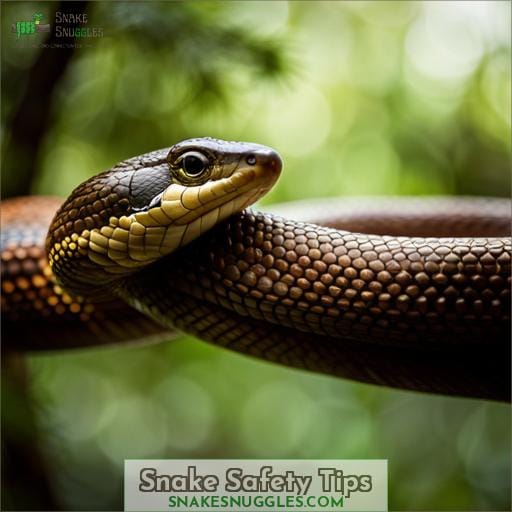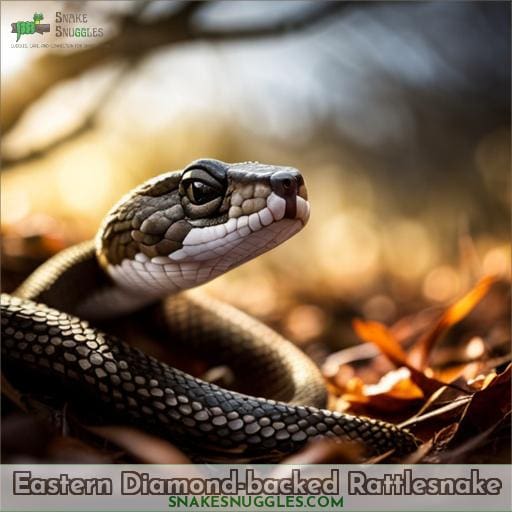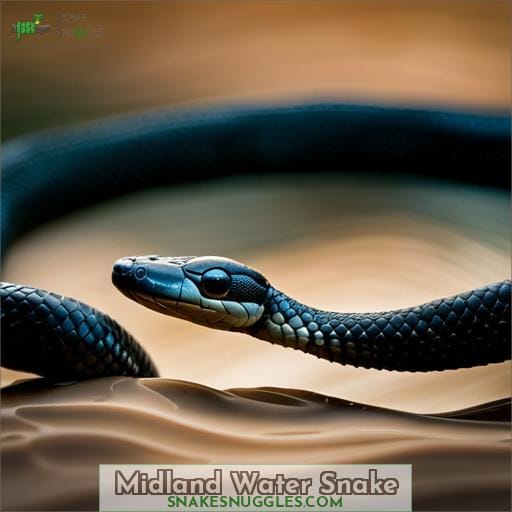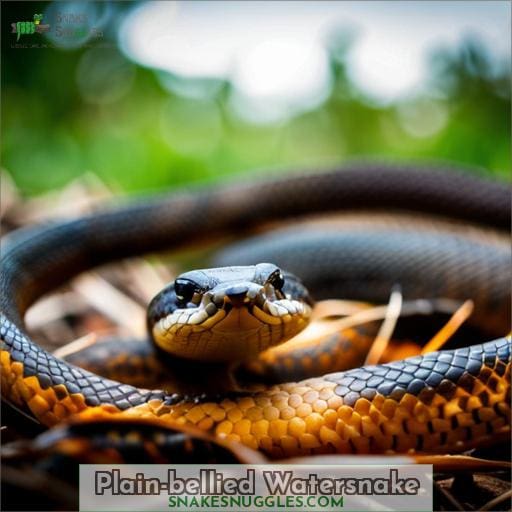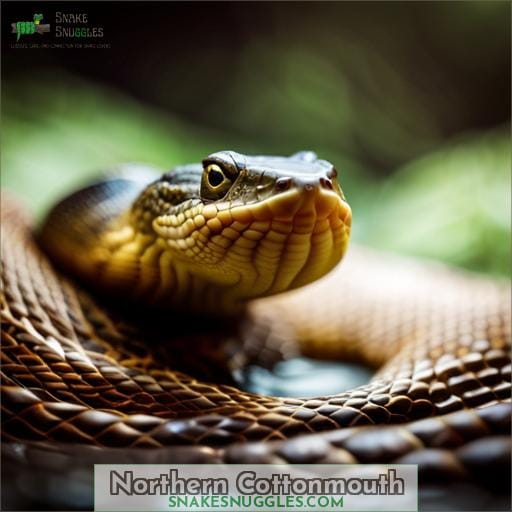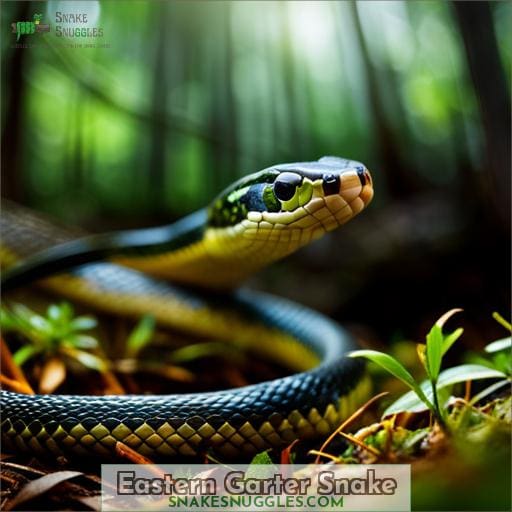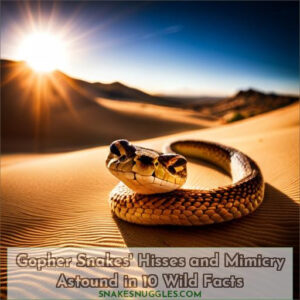This site is supported by our readers. We may earn a commission, at no cost to you, if you purchase through links.
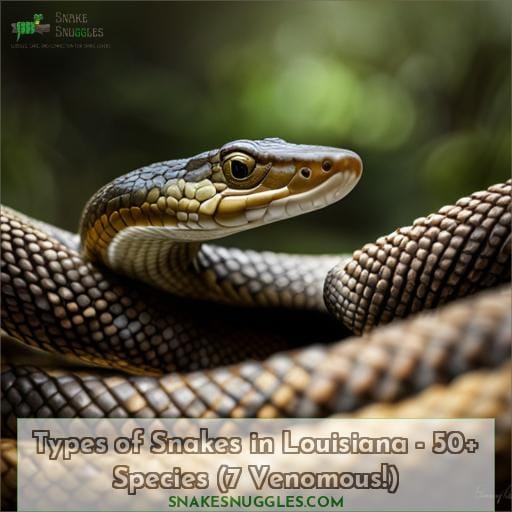 Strap on your snake boots and get ready for a wild ride! Louisiana is home to over 50 species of snakes, 7 of which are venomous. Knowing the types of snakes you might encounter in this state can help keep you safe as well as inform your appreciation for its local wildlife.
Strap on your snake boots and get ready for a wild ride! Louisiana is home to over 50 species of snakes, 7 of which are venomous. Knowing the types of snakes you might encounter in this state can help keep you safe as well as inform your appreciation for its local wildlife.
From the eastern diamond-backed rattlesnake to plain-bellied watersnakes, let’s take an in-depth look at each of these amazing reptiles that call Louisiana home. Take special note that even though some have weak or nonvenomous bites, they should all be treated with caution and respect while out exploring nature.
Table Of Contents
- Key Takeaways
- The Most Common Snakes in Louisiana
- Venomous (Poisonous) Snakes in Louisiana
- The Complete List of Snakes in Louisiana
- Other Reptiles Found in Louisiana
- Snake Safety Tips
- Eastern Diamond-backed Rattlesnake
- Midland Water Snake
- Plain-bellied Watersnake
- Northern Cottonmouth
- Eastern Garter Snake
- Frequently Asked Questions (FAQs)
- Conclusion
Key Takeaways
- There are venomous snakes in Louisiana, including the Eastern diamond-backed rattlesnake, timber rattlesnake, and pygmy rattlesnake.
- Copperheads can deliver painful bites, but they are not deadly.
- Coral snake bites are rare but powerful and can be serious.
- Cottonmouths are venomous snakes that strike without warning and can be identified by their white mouths.
The Most Common Snakes in Louisiana
In Louisiana, you’ll find seven venomous snakes and over 50 non-venomous species – from speckled kingsnakes to the massive eastern diamondback that can reach up to 8 feet long.
Brown snakes commonly lurk under vegetation in both urban and rural areas during warm weather.
Garter snakes are easily identified by their distinctive diamond-shaped heads and spotted bodies, while hognose snakes may bluff strike or even play dead if threatened.
The timber rattlesnake is dangerous thanks to its sharp fangs with toxic venom; pygmy rattlers tend to hide in flowerpots around yards but rarely grow bigger than 18 inches.
Copperheads have also been known for striking without warning causing painful bites, though not usually deadly; coral snake bites are much more serious due to their powerful yet rare presence in Louisiana habitats.
Rat Snakes, ribbon Snakes, pine Snakes, and milk Snakes all pose no risk of poisoning people but should still be respected as wild animals – give them space so as not to cause any unintended encounters!
Venomous (Poisonous) Snakes in Louisiana
With over 50 total snake species, Louisiana is home to a variety of venomous snakes. Among them are the Eastern Diamond Rattlesnake, Timber Rattlesnake, Pygmy Rattlesnake, Eastern Copperhead, and both Texas and Eastern Coral Snakes, as well as the Northern Cottonmouth (Water Moccasin).
All of these reptiles can cause serious injury if they are not respected and handled with care.
Eastern Diamond Rattlesnake
The Eastern Diamond Rattlesnake is the largest and heaviest of all Louisiana snakes, boasting an impressive eight feet in length. It hibernates during cold months and feeds on small rodents or birds. This venomous snake has few predators due to its defensive rattling sound that warns them off.
Its habitat ranges from woodlands to wetlands close to water sources, where it mates during springtime before giving birth in summertime litters of up to fifteen young at once.
When threatened by humans, they can bite with their potent venom but are not aggressive unless provoked– a lesson for all who live near these fascinating creatures!
Timber Rattlesnake
Be wary of the Timber Rattlesnake: its long, sharp fangs and highly toxic venom make it a dangerous snake.
Found primarily in Louisiana, this species is often seen basking on rocks or logs during warm days.
Venom potency varies greatly, so bite symptoms can vary too. Look out for intense pain and swelling at the wound site if bitten by a timber rattler!
Behavioral traits include boldness around humans, but they also hide when threatened.
Be aware that these snakes are present in Louisiana – knowledge of their characteristics may keep encounters safe for all involved!
Pygmy Rattlesnake
Beware of the Pygmy Rattlesnake, which can often be found lurking in flowerpots or other vegetation. It is common in many habitats, from wetlands to woodlands. Its venom potency varies depending on the region, but it’s much less powerful than its larger relatives like Timber Rattlesnakes.
Color patterns usually consist of shades of gray and brown with a dark stripe running down either side of its body. Diet habits include small rodents, as well as frogs and lizards. Defensive strategies include bluff striking if threatened by predators or playing dead if necessary.
Other snakes that coexist with pygmies are rat snake, ringneck snake, ribbon snake, and worm snakes.
Eastern Copperhead
Take caution if you encounter an Eastern Copperhead, as their venomous bite can be painful and cause tissue damage.
They live in wooded, grassy areas near water and feed on mice or frogs. Copperheads are shy creatures who often remain still when disturbed; they may strike without warning though!
Warning signs include a triangular head shape with yellow bands around the body & eyes that have vertical pupils like cats’.
When outdoors, remember: look before gardening – give space to any possible encounters – stay alert for flashes of white or rattles – seek help immediately after being bitten by a venomous reptile!
Coral Snakes (Texas and Eastern)
Cautiously watch for coral snakes, as their venom is highly toxic and rapidly acting if you’re bitten. Identifying the snake can be tricky. They have a distinct pattern of red, yellow, and black bands that wrap around their body.
They usually inhabit wooded areas or marshlands but may also be found near urban homes.
The western worm snake may look similar to a coral snake, so make sure to look out for its distinctive stripes when trying to identify one from another.
Non-venomous species in Louisiana include rat snakes, ribbon snakes, pine snakes, and milk snakes.
Northern Cottonmouth (Water Moccasin)
Be aware that the northern cottonmouth, also known as a water moccasin, is one of seven venomous snakes native to Louisiana. It has a distinct white mouth and can strike without warning when threatened or disturbed.
To avoid bites, stay away from areas where they might be living. Watch for flashes of white before approaching snake habitats.
Venomous snakes like this have unique habits, such as being able to swim and climb trees, so knowledge about their behavior is key for safety when encountering these creatures in nature. Always give them space and respect their natural environment while avoiding close contact with any snake species found around Louisiana wetlands or other areas near rivers and streams.
The Complete List of Snakes in Louisiana
Moving on from the venomous snakes one might find in Louisiana, let’s talk about all of the other varieties found there.
There are rat snakes, racers, garter and pine snake species which can be further broken down into their own subspecies.
Kingsnakes come in speckled, scarlet, and prairie varieties, while racers have tan yellow-bellied or blackmask colorings.
Watersnakes split off into midland diamondback or broadbanded variants, as well as mudsnake easterns and westerns; ringnecks to include southerns or mississippis; ribbons with orange stripes are Gulf Coasters, while corn snake rats, coachwhips, blindsnake also natively inhabit this area too!
Brown snakes often occupy urban & rural areas alike, lurking around vegetation, whereas common garters stand out due to their diamond-shaped heads & spotted bodies.
One should remember that hog-nosed specimens may bluff strike if threatened but will play dead when cornered – nothing like a timber rattler who has sharp fangs full of potent toxin!
Pygmy rattlers, meanwhile, usually procure flowerpots, making them more dangerous than you’d expect since they rarely exceed 18 inches long!
Copperheads, eastern ones at least, give no warning before striking, but coral snakes, although rare, boast powerful tissue-destroying venom, so obtaining medical aid is paramount following an attack from either kind of serpentine creature.
When venturing outside, it pays to be mindful yet respectful, allowing these creatures space enough for safe encounters away from potential harm.
Other Reptiles Found in Louisiana
In addition to snakes, Louisiana is home to a variety of other reptiles. Amphibians such as frogs and salamanders are abundant in the state’s wetlands and swamps. Frogs come in many sizes, colors, and diets; some may even be found living on land rather than near water sources.
Turtles can also be seen around Louisiana ponds or slow-moving streams. They usually feed on aquatic insects or plants like algae.
Lizards tend to inhabit warm areas like deserts or open grassy fields with plenty of vegetation for hiding spots while hunting prey items like small invertebrates or fruits/seeds.
With so many different amphibian behaviors, turtle conservation efforts, alligator habitats, lizard anatomies, and frog diets, there’s no shortage of interesting wildlife watching opportunities available throughout the Southern United States!
Snake Safety Tips
When outdoors in Louisiana, always be aware of your surroundings to avoid any unexpected encounters with snakes. Rattlesnakes and copperheads are the most common venomous species in the state, but other non-venomous ones may also pose a threat.
Here’s how you can stay safe:
- Listen for rattling and back away slowly if you hear it.
- Watch for flashes of white from cottonmouths or brownish hues from copperheads before striking.
- Be careful when gardening as pygmy rattlers can hide in flowerpots.
Keeping an eye out, avoiding threats by giving snakes space, and being mindful not to threaten them will help keep you safe from snake bites or encounters while enjoying nature in Louisiana!
Eastern Diamond-backed Rattlesnake
Be careful to keep your distance if you ever find yourself face-to-face with a powerful Eastern Diamond-backed Rattlesnake – it’s the largest and heaviest of Louisiana’s seven venomous snakes.
Distinguishable by its diamond-patterned body, this species has adapted hunting behavior that allows them to ambush their prey. As nocturnal predators, they can be found in various habitats ranging from pine flatwoods and hardwood hammocks to coastal dunes or marshes where they feed on small mammals, lizards, and frogs.
To identify an Eastern Diamondback rattlesnake, look for a large triangular head, dark brown coloration with lighter diamonds outlined in black along their back down into the tip of their tail. The tail contains several segments filled with hollow keratin that makes up its iconic rattle when threatened or startled.
Conservation efforts have been put into place due to habitat destruction, but more must be done for these important members of Louisiana’s ecology as well as other endangered snake species natively living there.
Midland Water Snake
The Midland Water Snake is a non-venomous species of snake that can be found in Louisiana. It has an average length of three feet and its scales are smooth with a brown or olive coloration, often speckled with black spots.
This species prefers to hibernate during the winter months and spends most of its time near bodies of water, where it hunts for prey such as fish, amphibians, small rodents, and insects. Its diet consists mainly of carnivorous items, but they will also consume some vegetation when necessary.
The habitat range includes both freshwater streams as well as saltwater coasts along the Gulf Coast region, so their presence is diverse across Louisiana’s landscape!
To protect itself from predators like birds or other reptiles, this species relies on camouflage combined with swiftness.
Breeding cycles usually occur during springtime after emerging from hibernation, which allows them to reproduce before summer arrives – laying anywhere between 8-20 eggs at once depending upon their size, age, condition, etcetera.
All in all, the Midland Water Snakes should not be feared unless provoked due to their nonvenomous nature, making them fairly harmless yet still fascinating creatures that deserve equal respect just like any other wildlife living within our state.
Plain-bellied Watersnake
You’ll find Plain-bellied Watersnakes in warm wetlands across Louisiana. These slender reptiles range from 3 to 4 feet long and can be identified by their black or dark brown bodies marked with yellow stripes running down the sides of their backs.
They feed mainly on fish, frogs, tadpoles, and other aquatic creatures but will also eat small mammals such as mice and voles if they come into contact with them. During the breeding season, males will fight each other for females, which is why they are sometimes seen near the water’s edge during this time of year.
The lifespan of a plain-bellied watersnake typically ranges between 10 to 15 years when living in the wild, although some have been known to live longer when kept in captivity due to better food sources available there – especially true for those that are fed commercial snake diets rather than being left alone outdoors where preying upon smaller animals may become more difficult over time due to its natural habitat becoming increasingly scarce or crowded out by human development surrounding it.
Northern Cottonmouth
The Northern Cottonmouth, also known as the Water Moccasin, is a venomous snake native to Louisiana.
This species has a wide head with an orange-brown coloration along its body that fades to almost black near its tail end. Its venom potency can vary depending on regional variations, but it is still considered quite dangerous if provoked or threatened by humans.
The snakes’ habitats are typically close to bodies of water where they hunt for food and hide from predators. However, due to human development and destruction of wetlands, their numbers have been declining drastically over recent years, leading to conservation efforts for this species being made in some parts of Louisiana.
In terms of behavior, these snakes are generally shy but become aggressive when disturbed or cornered.
Eastern Garter Snake
Be sure to look out for the Eastern Garter Snake – a common nonvenomous snake found throughout Louisiana – with its distinct diamond-shaped head and spotted body. This species is known for its high genetic diversity, which allows it to adapt quickly to changing environmental factors and habitat preferences.
The Eastern garter snake typically preys on small amphibians, insects, and worms but will also feed on other snakes if necessary. These defensive strategies help protect them from predators in their native environment.
When threatened, they may coil up or flatten their heads while hissing loudly as an additional defense mechanism against any potential attackers.
They are especially adept climbers, so be aware of your surroundings when entering areas where these reptiles might be present! Although this species can inflict a painful bite if provoked, they do not pose any serious threat of harm unless handled roughly or harassed too much – so respect these animals in their natural habitats at all times!
Frequently Asked Questions (FAQs)
How can I differentiate between venomous and non-venomous snakes?
To differentiate between venomous and non-venomous snakes, look for telltale signs such as diamond-shaped heads or a white mouth. Listen for rattles and back away slowly if confronted by one. Pay attention to coloration, size, and behavior before getting close enough to be bitten.
What is the best way to avoid a snake encounter?
To avoid a snake encounter, remain vigilant like an eagle and stay aware of your surroundings. Be on the lookout for flashes of white or diamond-shaped heads that could indicate the presence of copperheads or moccasins.
If you hear a rattle, slowly back away from the area and never provoke the snake. Give snakes their space to prevent them from feeling threatened by your presence.
What should I do if I am bitten by a snake?
If you are bitten by a snake, seek medical help immediately. Make sure to stay calm and still; do not move. Identify the species of snake if possible and inform your doctor. Wash the wound with soap and water for up to 15 minutes, but don’t apply ice or use a tourniquet as this may cause more harm than good.
Are there any snakes in Louisiana that are endangered?
Yes, there are several species of snakes in Louisiana that are listed as endangered. The Eastern Indigo Snake, the Red-bellied Mud Turtle, and the Black Pine Snake all face serious threats from habitat destruction and other causes.
Take caution when encountering these creatures to ensure their survival for future generations.
Are snakes active during the day or night?
Snakes are most active at night, but some species may be seen during the day. Copperheads and cottonmouths often bask in the sun, while pygmy rattlers hide under vegetation to stay cool.
Conclusion
With over 50 species of snakes, Louisiana offers a variety of reptilian experiences to intrepid adventurers. From the harmless common garter snake to the more dangerous Eastern Diamond Rattlesnake, there is no shortage of wildlife in the area.
No matter what kind of snake you find yourself face-to-face with, however, the most important thing to keep in mind is safety. Respect the wildlife, give them space, and always back away slowly if threatened.
As a symbol of the importance of respecting nature, remember to keep these types of snakes in Louisiana in mind next time you’re out in the wild.

